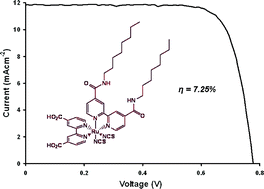Purification-free synthesis of a highly efficient ruthenium dye complex for dye-sensitised solar cells (DSSCs)†
Abstract
A novel Ru(II) sensitiser A597 containing the 4,4′-dioctylamido-2,2′-bipyridine ancillary

- This article is part of the themed collection: Contributions of inorganic chemistry to energy research

 Please wait while we load your content...
Please wait while we load your content...